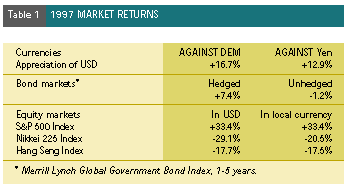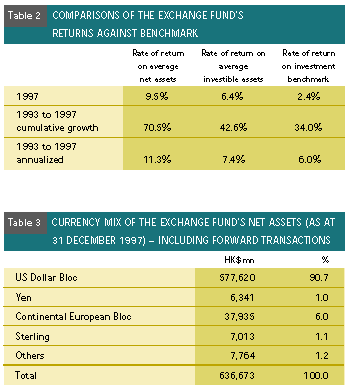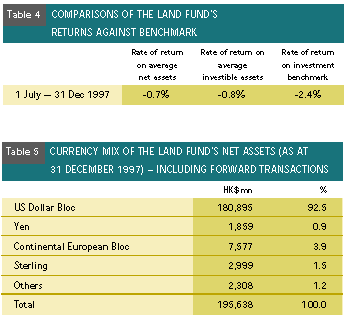Hong Kong Monetary Authority Annual Report 1997
RESERVES MANAGEMENT
At $719.2 bn, or $108,690 per person in the territory, the official reserves of Hong Kong represent a very significant store of value for the people of Hong Kong. The official reserves consist of assets from the Exchange Fund and the Land Fund which together provided foreign currency assets amounting to US$92.8 bn at the end of 1997. This placed the HKSAR Government foreign currency reserves as the third largest in the world, after Japan and the mainland of China.
The crucial lessons from the Asian financial turmoil that rocked the region since July 1997 highlight the importance of prudent asset-liability management and the critical role of risk management in the investing process. In managing the Exchange Fund, the HKMA has taken every care to ensure that the returns are achieved with low risk and minimum volatilities.
Although the Exchange Fund and the Land Fund are invested as separate portfolios, the HKMA adopts the same prudent investment, risk management and compliance guidelines to the management of both portfolios. The objectives of the funds are achieved in accordance with an investment process which is in line with international best practices.
OBJECTIVE
The HKMA manages the official reserves of the HKSAR Government as two separate portfolios, namely the Exchange Fund and the Land Fund. For historical reasons, the long-term investment strategies of the two funds are governed by slightly different objectives. However, the HKMA applies the same rigorous investment and risk management approach to the management of these portfolios.
THE EXCHANGE FUND
The Exchange Fund was established in 1935, and since its inception has held the backing to the note issues of Hong Kong. In 1976, the backing for coins issued and the bulk of the foreign currency assets held in the government's General Revenue Account were also transferred to the Exchange Fund. In the past decades, with recurring injections from continuous fiscal surpluses and under prudent management, the assets of the Exchange Fund grew dramatically. As at 31 December 1997, assets of the Exchange Fund totalled $636.7 bn (US$82 bn).
To safeguard the exchange value of the currency of Hong Kong, the investment of the Exchange Fund is governed by the triple objectives of liquidity, capital preservation and maximum long-term returns. To achieve these objectives, the Exchange Fund is managed as three separate portfolios: a Liquidity Portfolio to meet needs arising from monetary operations; a Hedge Portfolio to ensure that the obligations of the Exchange Fund will be met fully and an Investment Portfolio to generate long-term returns.
In the past, fiscal reserves were placed with the Exchange Fund as Hong Kong dollar deposits. This conservative approach was adopted with a view that the official reserves represent a significant store of value for Hong Kong and should not be subject to market risk. The official reserves have grown dramatically over the years and it has been decided that these reserves should be more actively managed to achieve a higher long-term real rate of return. This decision was announced by the Financial Secretary in the 1998/ 99 Budget Speech. With effect from 1 April 1998, the fiscal reserves previously placed as Hong Kong dollar deposits with the Exchange Fund will be actively managed by the HKMA as an integral part of the Investment Portfolio and Liquidity Portfolio such that the return on these government reserves will be linked to the performance of the Exchange Fund. This will effect the active management of substantial investment assets previously held passively in the Hedge Portfolio.
As the investment objectives, risk and return characteristics of this portion of the fiscal reserves are similar to that of the Exchange Fund, this change in the investment policy for these fiscal reserve placements will not require immediate changes in the strategic investment benchmark for the Exchange Fund. However, the resultant enlarged size of the actively managed portfolios will give rise to additional investment risks related to markets, operations and credit aspects during the investment process. The HKMA has concluded a thorough review of the investment process and related technological and risk management support to ensure that these increased risks will be carefully monitored and managed to generate steady, consistent returns with minimal additional volatilities.
At the same time, the Financial Secretary has asked both the Exchange Fund Advisory Committee and the Land Fund Advisory Committee to examine how to maximize investment returns while minimizing risk, and how to adjust the asset allocation of the two funds so that their investment policies can be aligned by 1 April 1999 as envisaged when the Government took over the Land Fund. The HKMA has already taken steps in this direction by adopting the same risk management controls and standards towards the investment process of both the Exchange Fund and the Land Fund.
THE LAND FUND
Annex III of the Sino-British Joint Declaration directed that the premium income obtained from land transactions during the period commencing from the entry into force of the Joint Declaration (27 May 1985) until 30 June 1997 be shared equally between the British Hong Kong Government and the HKSAR Government. The Hong Kong Special Administrative Region Government Land Fund Trust was set up in 1986 to receive and hold this share of income. Upon the establishment of the HKSAR Government on 1 July 1997, the assets of the Land Fund Trust were transferred by the Trustees of the Land Fund to the Government of the HKSAR. Mr C H Tung, the Chief Executive of the HKSAR appointed the Financial Secretary as the public officer to receive and hold the assets of the Land Fund as part of the government reserves. Subsequently, the Land Fund was established by a resolution made and passed by the Provisional Legislative Council on 23 July 1997 under section 29 of the Public Finance Ordinance.
The Land Fund is now managed by the HKMA under the direction of the Financial Secretary as a separate portfolio from the Exchange Fund. The Financial Secretary has established the Land Fund Advisory Committee to advise him on the investment strategy and management of the Land Fund.
The investment of the Land Fund is governed by the following objectives: to preserve capital and to maximize investment returns over a time horizon of 5 years, without disturbing the stability of the financial system of Hong Kong. In practice, these objectives are translated into explicit policies with regard to investment decision making, evaluation and risk management.
INVESTMENT FRAMEWORK
The authority for the investments of the Exchange Fund and the Land Fund rests with the Financial Secretary, who consults with the Exchange Fund Advisory Committee and the Land Fund Advisory Committee to establish the long-term strategic investment direction of the two funds.
INVESTMENT BENCHMARKS
The long-term strategic direction of the two funds are incorporated into an investment benchmark for each fund. This investment benchmark, or preferred neutral position, is based on the risk t o l e rance and long-term return expectations of the fund and defines the allocation of investments to bonds and equities by country as well as the overall currency composition of the fund. The construction of the strategic investment benchmark of the Exchange Fund and the Land Fund were both based on a quantitative method for asset allocation that has been well-tested and is commonly used by the international investment community. The strategic investment benchmarks permit the Exchange Fund to invest in 14 bond markets, 9 equity markets and 18 currency markets and the Land Fund to invest in 19 bond markets, 18 equity markets and 19 currency markets.
The strategic investment directions are set by the Advisory Committees and the day-to-day management of the Exchange Fund and the Land Fund is conducted by the Reserves Management Department and the Land Fund Office of the HKMA respectively. In carrying out their responsibilities, both parties operate under authority delegated from the Financial Secretary and within investment guidelines approved by the Exchange Fund Advisory Committee and the Land Fund Advisory Committee. Both parties are involved in tactical allocation of assets to specific markets with the strategic investment benchmarks as references. Based on fundamental analysis of economies and assessment of market development and trends, these investment professionals determine the allocations to asset classes by countries and the appropriate timing for entry into and exit from markets. To generate returns above market returns, these professionals also engage in the selection of specific securities within each market. In these endeavours, the Reserves Management Department and the Land Fund Office follow guidelines which include maximum deviations from the strategic investment benchmark, credit risk guidelines and a list of permissible instruments as well as limits on investments in these instruments as authorized by the Advisory Committees.
USE OF EXTERNAL MANAGERS
Both the Exchange Fund and the Land Fund employ external managers to invest about 20% of their total assets. The Exchange Fund currently employs over 20 external managers located in 7 financial centres, while the Land Fund employs over 10 external managers spread over 6 countries. The purpose of engaging the services of external managers i s to benefit from their expertise, skills and geographical coverage in selected markets. Within the Reserves Management Department and the Land Fund Office are divisions dedicated to monitoring the investment activities undertaken by the external managers for compliance and to analyzing their investment performance in order to determine the value-added provided by these external managers. The assets being managed by external managers are vested in specially chosen custodian.
The HKMA assigns investment benchmarks to all its external managers. The investment benchmark, together with guidelines and limits, acts as a set of instructions to the external manager and establishes the level of risk that the external manager is permitted to assume in order to generate returns. Market indices common to the investment community are preferred, but to meet the specific needs of certain types of portfolios, customized benchmarks are also used as and when required.
In addition to verifying that all transactions conducted are in strict compliance with guidelines, the external manager monitoring divisions also engage in the analysis of investment performance achieved by these external managers. The external managers are ranked according to their performance against benchmark, and the deviations away from benchmark are tracked and analyzed to determine their effectiveness in generating additional returns from the risks assumed. The external managers are also ranked in terms of administrative efficiency and accuracy. External managers who consistently outperform in all these aspects are rewarded with additional funds for management while investment mandates to persistent under-performers are terminated.
RISK MANAGEMENT AND COMPLIANCE
The risk management and compliance divisions at the Exchange Fund and the Land Fund are crucial to the risk control function. These divisions are responsible for measuring performance and risks arising from the investment process. In addition to evaluations of return against benchmark and performance attribution analysis, the portfolios are also tested for risk using the latest tools in the market. Value-at-risk as well as scenario stress testing are used to quantify the market risks inherent in the portfolios under normal as well as extreme adverse market conditions. The respective Risk Management Divisions also ensure the credit worthiness of counterparties, custodians and external managers through regular credit reviews and with reference to ratings by internationally accepted independent rating agencies.
PERFORMANCE
THE FINANCIAL MARKETS IN 1997
In 1997, the markets generally accepted that the EMU will start on time in 1999; and that the US will continue its buoyant economic growth without inflation. In Asia, Japan descended into recession as the IMF provided rescue packages to Thailand, Indonesia and then Korea to bail them out of economic difficulties. The financial markets responded to these events by buying US dollar assets and fleeing Asian markets and currencies, while remaining relatively calm in Europe. The performances of the currencies and major equity and bond markets are provided in Table 1 below.

THE EXCHANGE FUND PERFORMANCE IN 1997
The investment strategy of the Exchange Fund steered a steady course through financial turmoil. The primary objectives were the vigilant need for liquidity and steady and low volatility returns amidst turbulent markets. Fortunately, the Fund enjoyed a favourable interest rate environment in the second half of the year; and was able to partially mitigate the negative impact of the strong dollar on its returns by a defensive currency allocation within the limits set by the investment guidelines. In 1997, the rate of return on the Exchange Fund's average net assets was 9.5%, and the return on average investible assets (assets net of interest bearing liabilities) was 6.4%. Both compare favourably with the return on the benchmark of 2.4%. A comparison of the Exchange Fund's return against its benchmark for the five years from 1993 to 1997 and for 1997 is at Table 2. The currency mix of the Fund's assets as at 31 December 1997 is provided in Table 3.

THE LAND FUND PERFORMANCE IN 1997
Unlike the Exchange Fund which is predominantly invested in OECD bond and equity markets, the investment benchmark of the Land Fund allocates some exposure to the Asian equity markets. Amidst the Asian turmoil which had a contagion effect within the region, precautionary steps were taken early in the summer to reduce the holdings in the Asian markets. Overall exposure to equities was also decreased and the proceeds reinvested in cash and bonds. For the half year ended December 1997, the Land Fund lost 0.8% as compared to the benchmark return of minus 2.4%. The half year loss was largely attributed to the sharp decline in Hong Kong equity prices which were partially offset by income generated from investments in bonds and deposits. Hong Kong equities accounted for 7.1% of the total Land Fund. The uncertain investment environment is expected to continue into 1998 and a defensive strategy has been adopted to ensure capital preservation of the Land Fund.
A comparison of the Land Fund's returns against investment benchmark for the second half of 1997 is at Table 4. A currency mix of the Land Fund as at 31 December 1997 is provided in Table 5.

CHALLENGES
1998 began with another round of currency collapse in Asia. By early 1998, concerted efforts from the IMF and various governments have abated the immediate fears, but the Asian crisis will remain at the centre of the global investment outlook for the rest of the year. While the economic malaise brought about by Asia's turmoils will contribute to slower growth and controlled inflationary expectations globally, the financial markets remain highly nervous and volatile in the emerging and advanced markets.
Since the fourth quarter of 1997, both the Exchange Fund and the Land Fund have incorporated defensive measures against market volatilities and unexpected turn of events for the worse in Asia. With improved risk management tools, the HKMA will continue to manage both the Exchange Fund and the Land Fund prudently to achieve the combined objectives of liquidity, capital preservation and an adequate return on assets. The goal is to achieve consistent returns with minimum volatility.